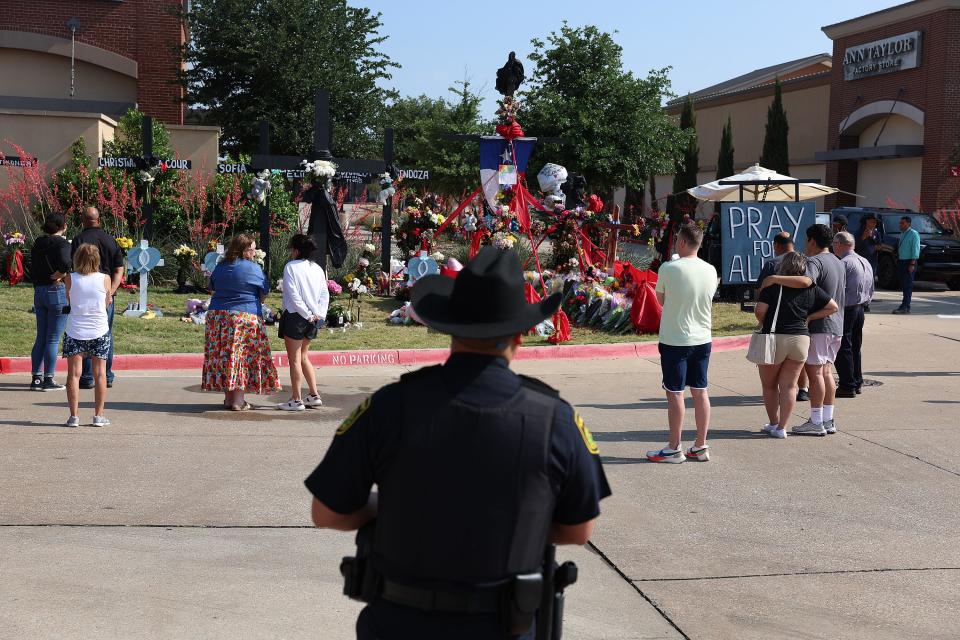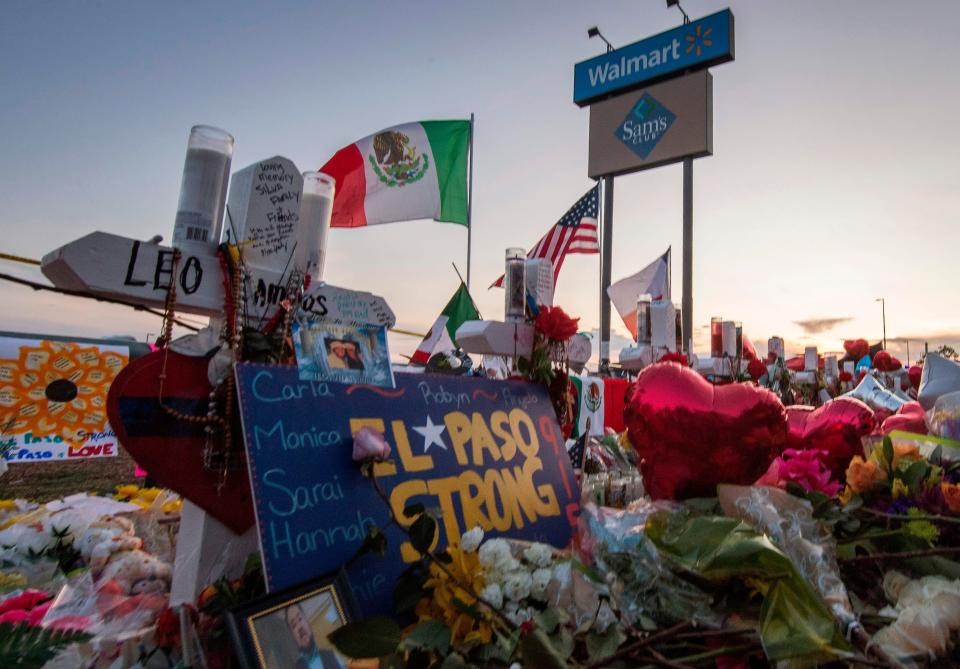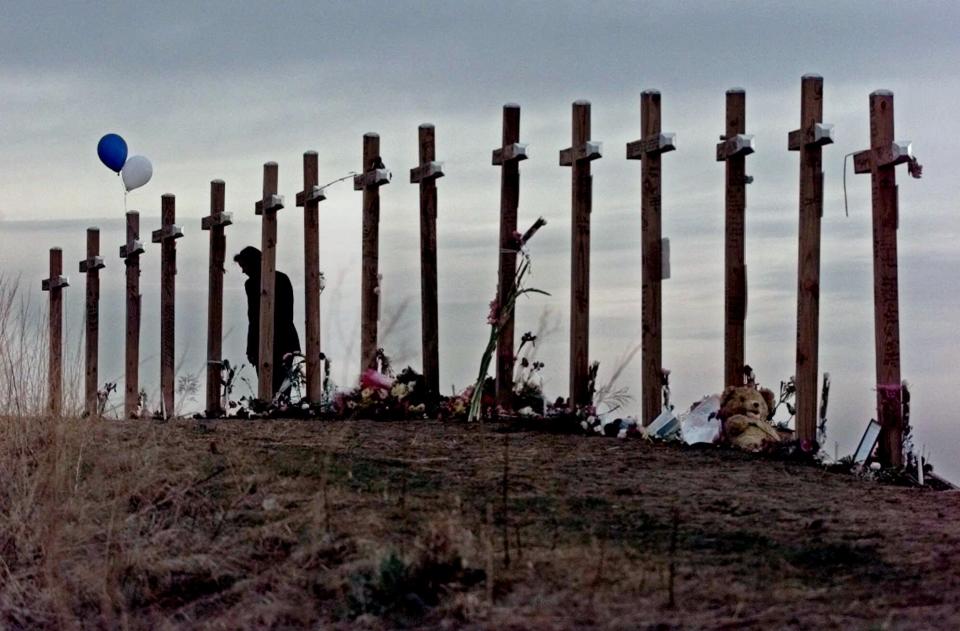The Allen shooter was Hispanic. He was also a white supremacist. What's the allure?
- Oops!Something went wrong.Please try again later.
In the last few days, the country has learned a lot about Mauricio Garcia, the man who police say opened fire at a busy shopping mall in Allen, Texas, on Saturday, killing eight people and wounding 10 more.
Garcia, experts say, left behind a trove of social media posts that delve deep into his psyche. Ramblings, pontifications and pains are laid out in hundreds of handwritten pages that were photographed and placed on the Russian social media site Odnoklassniki (“classmates”) or Ok.Ru, by an account that apparently belonged to him. These pages appear to form a kind of diary.
Based on the posts attributed to him, a picture has become clear: Garcia had a deep and passionate interest in facets of far-right extremism, especially misogyny, white supremacy and anti-Semitism. Perhaps most starkly, Garcia posted photographs of his neo-Nazi tattoos — a large swastika on his chest, and the letters “SS” on his right arm. Law enforcement officials have since confirmed the shooter had tattoos and patches expressing a “neo-Nazi ideation.”

White supremacist groups in the United States are usually clear on supporting northern European white identity, and rejecting all others, including Latinos. So why would Garcia, who identified as Hispanic, follow a philosophy that would consider his own identity inferior?
While Garcia’s specific family history has not been publicly detailed, the reality is that strains of white supremacy run through many different cultures. White supremacist sects exist across Latin America, a reflection of the complex nature of “whiteness” in the Western Hemisphere.
But for Garcia, neo-Nazism may have held a more visceral allure: Its thirst for violence and conflict has long fueled mass shooters, regardless of their views on race.
And American history has seen rare cases of Brown- and even Black-skinned neo-Nazis, said Mark Pitcavage, a senior research fellow at the Anti-Defamation League’s Center on Extremism.
“When you have a population of 330 million, the bell curve can produce some odd outliers from time to time,” Pitcavage said. “There are certainly indications of violence in the writings, and tons of indications of white supremacy, but also many indications of mental health issues.”
What did the Allen shooter post?
USA TODAY reviewed hundreds of postings from the Odnoklassniki profile identified as Garcia’s. The profile included photographs of a plane ticket and a traffic citation in Garcia’s name, and a photo of a childhood identity card in the name Mauricio Garcia, with a date of birth matching that of the Allen shooter.
The postings, which were shared with USA TODAY by the Global Project Against Hate and Extremism (GPAHE) and confirmed in analyses by the Anti-Defamation League, GPAHE and others, revealed a clearly disturbed poster who expressed hatred toward non-whites, particularly people of Arab or Asian descent.
The poster also spread anti-women ideas and quoted hateful comments from Andrew Anglin, the neo-Nazi who runs the web site the Daily Stormer.
“Garcia also used phrases and imagery, such as ‘Deus Vult’ and Crusader crosses, that are commonly used as anti-Muslim symbols,” reads the ADL’s Center on Extremism analysis of the shooter’s posts. “One T-shirt Garcia purchased and wore featured a Crusader and the phrase ‘I will see your Jihad and raise you a Crusade.’ Garcia even got a ‘Deus Vult’ tattoo to match his neo-Nazi tattoos.”
Garcia was also clearly steeped in the white supremacist media ecosystem.
According to a GPAHE analysis of his posts, in addition to the Daily Stormer, Garcia shared information from a eugenics advocate, a Holocaust denier and extremists who advocate for a race war. Many of the postings were obsessed with race, misogyny and anti-Semitism.
They match the beliefs of a long line of racist mass shooters in recent years, including a white man from Allen who killed 23 people at an El Paso Walmart in 2019; a white man who shot and killed 11 people at the Tree of Life synagogue in Pittsburgh a few months later; a white man who shot and killed 10 people at a Buffalo supermarket last year.
With one notable difference: Garcia was of Hispanic heritage.
Complex history of “white” and “Hispanic”

Demographers consider Latino identity to be an ethnicity, and Census data identifies a majority of Hispanic Americans as white.
Particularly in the American Southwest, though, the mere concept of “white” is a thorny and complex issue, said Christina Sisk, an associate professor in the Department of Hispanic Studies at the University of Houston.
Much of the Southwest was colonized by people from Spain and Spanish Mexico, she said. And while many lighter-skinned people of Spanish descent long considered themselves “white,” the newly formed United States, with its power centers in the faraway Yankee northeast, designated people of Spanish origin as “Hispanic,” as opposed to white people who were of Northern European heritage.
“It's fairly common not to think of Mexican Americans as white, although we do get the acceptance of some Latinos as white,” Sisk said. “The Southwest was settled by Spaniards, actually, and it gets very difficult to distinguish the colonizer and the colonized.”
The very concept of “whiteness” is also far from constant across the world, said Tanya Katerí Hernández, a law professor and author of “Racial Innocence: Unmasking Latino Anti-Black Bias and the Struggle for Equality.”
“Latinos are a pan-ethnic grouping, within which we have great racial diversity,” Hernández said. In Latin America, people of white, Black, Native American and Asian descent may also consider themselves Hispanic.
There can also be strains of racial bias even within Hispanic groups, said Pedro Rios, a human rights advocate who directs the American Friends Service Committee’s U.S./Mexico Border Program. Rios described traditions of discrimination against Latinos with darker skin.
“Within the larger Latino community, there are always people who might affiliate themselves with a whiteness and an identity,” Rios said. “And in that sense, they will espouse white supremacist ideology, because they negate their ancestral indigenous origins.”
Whatever Garcia’s motivations, Hispanic racial tensions with Arab or Muslim cultures date to the Middle Ages.
But as far as American white-supremacist extremists are concerned, most do not consider anybody other than people descended from Northern Europeans as “white,” Pitcavage said.
On white supremacist forums, for example, Pitcavage said, people of Hispanic origin who post photos of themselves are largely spurned by other white supremacists, who maintain that their racist world cannot include anyone with a Latin last name or a single drop of non-northern European blood.
Garcia, himself, seems to have bought into this view. In a telling post from the online diary attributed to him, he recounts a conversation:
"This white guy came up to me when I was on assignment, I don't even know how it came up but he said 'Are you Hispanic?' I told him 'Yuck don't remind me … I'm Hispanic weather I like it or not." (sic)
When the obsession is Nazis, not race

Garcia seems to have been obsessed with race. But racism isn’t always what attracts people to neo-Nazism, Pitcavage said.
Recent history has several examples of mass shooters and other domestic terrorists who were drawn to the history of the Nazis and the modern neo-Nazi movement not necessarily because of race politics but because of what Hitler and the Nazis stood for in terms of death and destruction.
For people bent on causing harm, the Nazis hold a sort of fascination, Pitcavage said. A stark example is the shooters in the Columbine High School massacre in 1999 — largely considered to be the first in the modern wave of senseless school shootings. The Columbine shooters, Eric Harris and Dylan Klebold, who murdered 12 students and one teacher, weren’t particularly interested in race politics — indeed, Klebold’s mother was Jewish.
Nonetheless, the pair carried out their attack on April 20 — Hitler’s birthday.
“People — including people who are non-white – can develop an interest or obsession in Nazis or white supremacist killers because they themselves have become obsessed with murder and death and mass killings in general,” Pitcavage said. “People have been arrested for committing or plotting some sort of mass shooting and when search warrants are executed, they find they've got all this material — pictures of Hitler or death camps or this or that. It's not that they're necessarily sympathetic to white supremacy, what fascinates them is the killing aspect.”
This could be relevant in Garcia’s case, Pitcavage said, because despite the large volume of racist and misogynist posts in his social media archive, Garcia didn’t leave behind any clear indication of his actual motive for Saturday’s shooting.
Other racist shooters have specifically created documents laying out their grievances and their reasons for committing their atrocities. Garcia didn’t do that. The posts attributed to him leave behind a confusing and troubled trail of racism and hate, without ever expressing a desire to commit a mass shooting, or what he hoped to achieve by doing so, Pitcavage said.
One motif Garcia apparently scribbled in the margins of much of his writing, and that he even got tattooed on his left upper arm, was the number 10/6, an apparent reference to the price tag on the hat worn by the Mad Hatter character in Lewis Carrol’s classic novel “Alice in Wonderland.”
The postings suggest that Garcia himself “strongly suspects that he's a psychopath,” Pitcavage said. “So he gives just as many indications of mental demons as he does white supremacy or right-wing extremism.”
This article originally appeared on USA TODAY: Mauricio Garcia, shooter in Allen, Texas: Allure of neo-Nazi ideas

